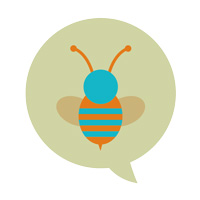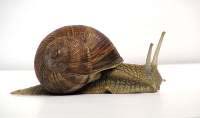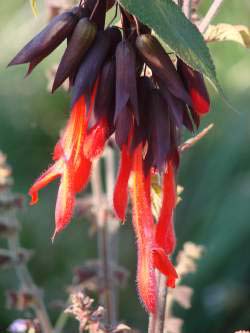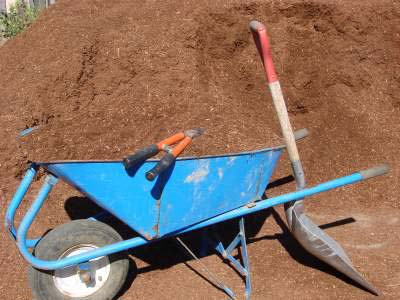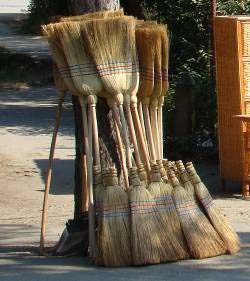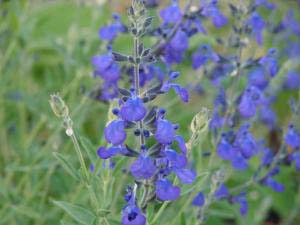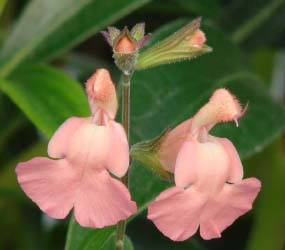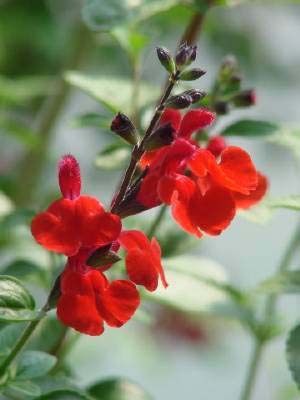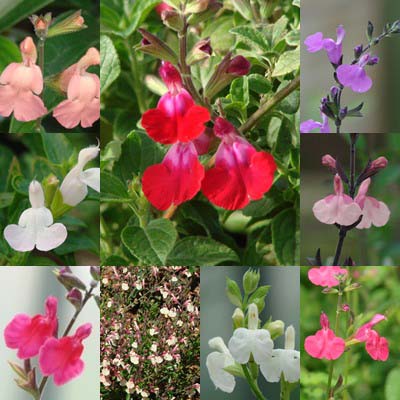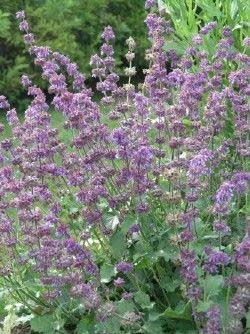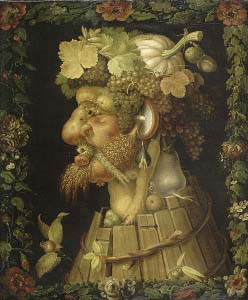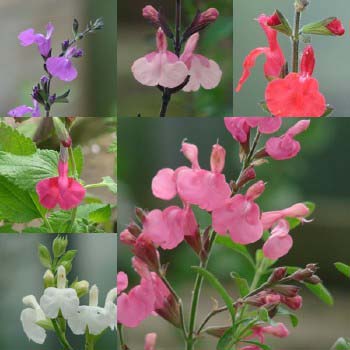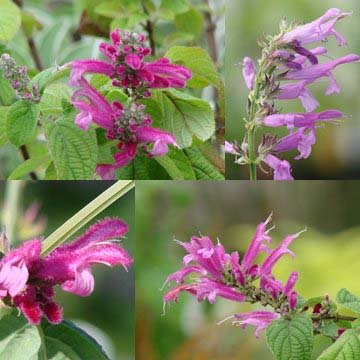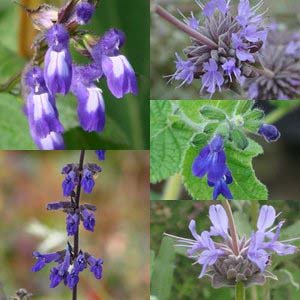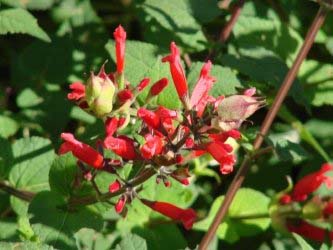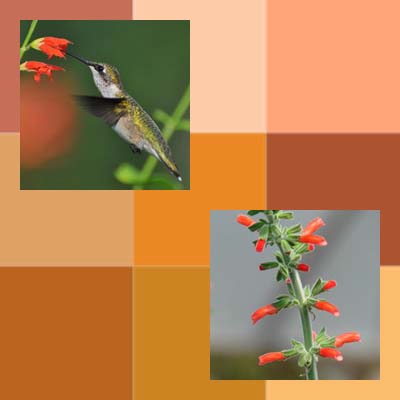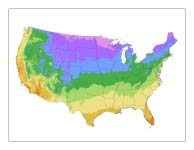
We began publishing our Everything Salvias blog in 2010 for your enjoyment and to help you "get it right" when growing sages that are often unavailable at local garden centers.
It seems like there is an endless bounty of stories to be told. But that's to be expected when covering a genus containing an estimated 900 species -- the largest group within the mint family (Lamiaceae). In addition to Salvias, we write about other species that are either mint family members or low-water companions for our many drought-tolerant Salvias. We welcome comments as well as suggestions for future blog posts.
To access articles rapidly based on your interests, please click on the categories below, which include do-it-yourself videos (Views from the Garden). But please note: This is a dangerous place for a sage lover.
| Explore the Categories: | ||||
| | | | | |
| | | | | |
| | | | | |
| | | | | |
| | | |||
Posted: Wednesday, October 10, 2012
Synopsis: Cleaning up leaf litter, weeds and mulch around Salvias can greatly reduce snail and slug attacks.
Read the Article
Posted: Wednesday, October 10, 2012
Synopsis:
Of all the mint family's more than 6,500 species worldwide, Giant Bolivian Sage (Salvia dombeyi) has the longest blossoms and tallest growth. Each tubular crimson flower grows up to 5 inches long and has a burgundy calyx at its base.The plant's bright green, heart-shaped leaves are equally long. In South America, the flowers are pollinated by hummingbirds with extremely long beaks. However, Giant Bolivian Sage don't need pollination to flower beautifully for many seasons if growing conditions are right.
Read the Article
Posted: Saturday, October 6, 2012
Synopsis:
When your order arrives from Flowers by the Sea, open it up right away. What will you see? No plastic wrapping, that’s for sure. At FBTS we think plastic wrap is a poor packaging choice, because it speeds decomposition. Sending you plants that are beginning to mold and rot is the last think we want to do.
Read the Article
Posted: Monday, October 1, 2012
Synopsis:
Sometimes it’s wise not to get too tidy in the garden. When preparing Salvias for Winter dormancy, moderation is the rule. Regional climate affects how much trimming and mulching are necessary in late autumn.
Read the Article
Posted: Sunday, September 30, 2012
Synopsis:
You don’t usually have to fuss over Salvias to give them what they need. Yet the end of fall and other growing seasons are good times to seek solutions to problems that affect plant vigor. It is a time for a call to attention as well as a cleanup call to action.
Read the Article
Posted: Sunday, September 23, 2012
Synopsis:
Sometimes surprises occur in the garden, especially if you plant Salvias. Sages in the Salvia greggii and Salvia microphylla Group are particularly inclined to hybridize naturally.
Read the Article
Posted: Saturday, September 22, 2012
Synopsis:
Planning a flowerbed with pastel bicolored Salvia x jamensis is a bit like organizing a fancy sweet 16 birthday party. It takes finesse and the right guest list of complementary perennials and annuals for fun and harmony. These Salvias are colorful, but not boisterous flowers.
Read the Article
Posted: Wednesday, September 19, 2012
Synopsis:
As with so many aspects of life, the hummingbird-Salvia relationship is circular. It is difficult to have one without the other. Unfortunately, many species of hummingbirds are threatened or endangered. By planting Mountain Sage (Salvia microphylla) you invite hummingbirds into your garden, expand their habitat and ensure pollination for abundant blossoming.
Read the Article
Posted: Friday, September 14, 2012
Synopsis:
It would be inaccurate to refer to the woody perennial Autumn Sage, or Salvia greggii, as coming in a rainbow of colors, because there is no true blue in the bunch. However, S. greggii cultivars form a riot of lipstick-intense reds, pinks, corals, apricots, oranges, lavenders and purples. Whites, pale yellows and bicolors also are members of the vivid species discovered in the dry, rocky landscapes of Texas and Northern Mexico by 19th century frontiersman, doctor, trader, writer and amateur botanist Josiah Gregg.
Read the Article
Posted: Monday, September 10, 2012
Synopsis:
It can be a long journey from discovery to popularity for a plant. Currently, the most widely sought group of Salvias is the one encompassing S. greggii, and S. microphylla, which are commonly known as Autumn Sage and Mountain Sage. They caught the eye of naturalists traveling the American Southwest and Mexico's Sierra Madre mountains in the mid-to-late 1800s. However, they didn't take root in garden catalogs for well over 100 years.
Read the Article
Posted: Friday, September 7, 2012
Synopsis:
In the days following the terrorist destruction of New York’s World Trade Center on September 11, 2001, one article in The New York Times focused on the recovery of 30 acres of gardens of the Battery Park City Parks Conservancy a few blocks south of where the Twin Towers once stood.
Read the Article
Posted: Thursday, August 30, 2012
Synopsis:
While it's true that not all Salvias smell, well, pleasant, many varieties are grown specifically for the aromatic or even sweet aromas that they release into the air. These ten Salvias are our top picks for the best-smelling varieties in the garden.
Read the Article
Posted: Tuesday, August 28, 2012
Synopsis:
Creating a flower garden in partial shade is not as challenging as planting in full shade, yet it requires selecting the right plants. Herbaceous Chinese Salvias can form a harmoniously composed partial-shade garden that soothe the eye with calming pastels.
Read the Article
Posted: Thursday, August 9, 2012
Synopsis:
Fall is the best time to plant many Salvias. Read on to find out why . . .
This picture, "Autumn", was painted by Giuseppe Arcimboldo in 1573.
Read the Article
Posted: Sunday, May 6, 2012
Synopsis:
Without a doubt, this group of closely related plants are the most widely grown of the genus. From 'Hot Lips' to 'Texas Wedding', there is something here for everyone.
Read the Article
Posted: Tuesday, December 27, 2011
Synopsis:
Small Flowered Pink & Purple Species
Part I of this series took up some of the early Winter bloomers, Part II the blue and dark purple flowered varieties. Here we look at four of the small flowered, purple to violet varieties.
Read the Article
Posted: Saturday, December 10, 2011
Synopsis:
The Blue Species
When I think of Winter blooming "font-style: italic;">Salvias, the warm colors – red, orange and pink – come to mind first. Possibly because THE most spectacular Sage of all, "font-style: italic;">Salvia gesneriifolia 'Tequila', is a presence to contend with, growing for us over 16 feet tall and 30 feet across! But looking around our gardens this cool day, there are a number of very fine blue and purple Sages in bloom now. So in Part 2 of the Winter "font-style: italic;">Salvia series, we’ll discuss these fine plants.
Read the Article
Posted: Saturday, November 26, 2011
Synopsis: Some of the most dramatic Salvias bloom in the Winter. Most of these are from Southern Mexico, and are very well adapted to grow in Zone 9 gardens.
Read the Article
Posted: Sunday, August 3, 1969
Synopsis:
You'll hear a lot about red when planting annuals for wildlife gardens, because hummingbirds garden love red, tubular, nectar-rich flowers. But orange is another hummingbird favorite not to be neglected. Flowers by the Sea suggests five long blooming species for your landscape that begin shouting "Orange, orange, orange" in spring when hummingbirds are big-time hungry now, now, now as they head north for the nesting season.
Read the Article
Posted: Tuesday, July 22, 1969
Synopsis:
To provide you, our friends & customers with the very best service possible, we have a new telephone number.
Read the Article
Posted: Tuesday, July 22, 1969
Synopsis:
Its warmer than you think.
The new 2012 version of the USDA Hardiness Zone Map puts almost everyone into a higher Winter Zone.
Read the Article
Posted: Tuesday, July 22, 1969
Synopsis:
Synopis: In high-altitude, dry climates, some afternoon shade is good for full-sun Salvias.
Read the Article







